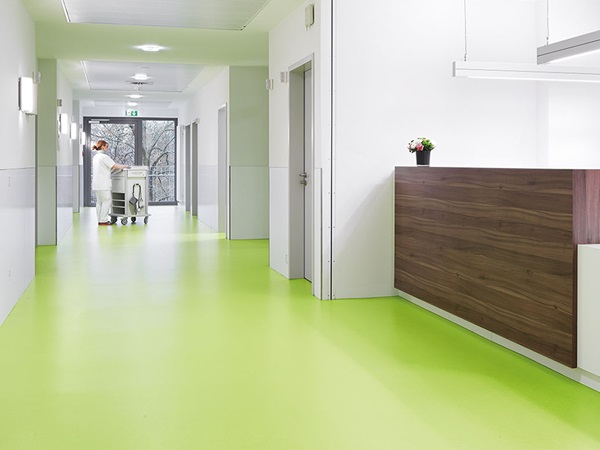
Hygienists worldwide are focused on how they can create the optimal healing environment for patients, families, and caregivers with a focus on preventing the transmission of hospital acquired infections (HAIs). Building materials are becoming increasingly important in efforts to effectively reduce the transfer risk of infectious diseases. Safe hygienic solutions such as nora rubber flooring are essential.
nora rubber floors are particularly hygienic
The materials your healing environment is equipped with have a direct effect on protection against germs. The large area that flooring occupies in your rooms makes it an important focus for sterility measures.
nora rubber floors are not only coating free and easy to clean, they can also be completely disinfected. This makes them ideal for use in high-risk areas that must be sanitized frequently. This includes operating and recovery rooms, intensive care units, and isolation areas. Reports from hospital hygienists endorse the hygienic properties of nora rubber.
Rubber – the foundation for cleanliness
Due to their watertight non-porous surface, nora floors repel germs , giving them little to no opportunity to propagate. In addition, nora floor coverings are either grouted or laid seamlessly end-to-end. This results in valuable benefits for your hospital:
- Being dimensionally stable, the floors never shrink, ensuring all seams are permanently sealed
- Torn, unsanitary joints cannot develop
- As a result, the surface remains permanently hygienic even at the joints
Complete system for seamless hygiene
Developed especially to drive positive patient outcomes in hospitals and other healing environments, noraplan environcare and noraplan sentica are complete flooring systems, including a first-class collection of accessories. With prefabricated interior and exterior corners, ensuring sterile wall junctions is easy. The complete system of perfectly matched and shaped elements helps consistently prevent bacterial buildup.
Clear recommendation from hospital hygienists for risk areas
Expert opinions and numerous references demonstrate that nora floor coverings offer excellent support for infection control in your healthcare setting. Joint-free installation is a particularly important point noted by infection control experts, as the seamless surface does not permit any bacterial buildup over the long-term.
A recent study by the Institute of Medical Microbiology and Hospital Hygiene at the University of Marburg gave an impressive demonstration. Professor Mutters, head of hospital hygiene at the institute, says:

“With coverings that are not dimensionally stable, joints can rupture. As a result, unhygienic cracks form. Joints in general collect dirt more easily than the flat surface of the floor. The resulting build up of bacteria can be avoided with the tight end-to-end installation."
The flooring was tested for its ability to be fully disinfected under real-life conditions. For this test both grouted and end-to-end flooring was installed and tested.
Result: The hygienic standard of all installation variants tested was very high. This makes them suitable for use in high-risk areas.

 USA | English (US)
USA | English (US)